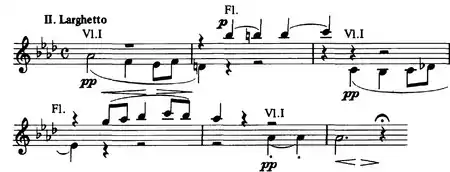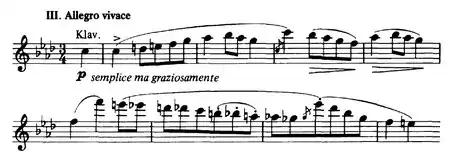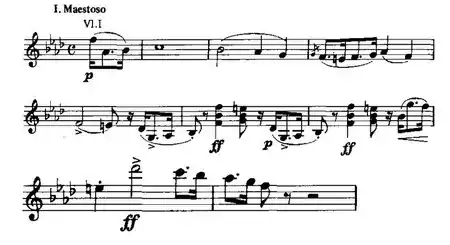Piano Concerto No. 2 (Chopin)
The Piano Concerto No. 2 in F minor, Op. 21, is a piano concerto composed by Frédéric Chopin in 1829. Chopin wrote the piece before he had finished his formal education, at around 20 years of age. It was first performed on 17 March 1830, in Warsaw, Poland, with the composer as soloist. It was the second of his piano concertos to be published (after the Piano Concerto No. 1), and so was designated as "No. 2", even though it was written first.

Structure
The work contains the three movements typical of instrumental concertos of the period:
- Maestoso (F minor)
- Larghetto (A-flat major)
- A work of "undescribable beauty",[1] this nocturnal movement was inspired by Chopin's distant idolization of Konstancja Gładkowska. The main theme (the "A" section) is introduced by the piano after an orchestral introduction and is later repeated twice and again, at measure 82 (the start of the coda), is enhanced by the sublime entrance of the bassoon in canon, followed by the bassoon transitioning to a counter-melody.

- Allegro vivace (F minor – F major)
- The virtuosic finale is in rondo form. The violins and violas are at one point instructed to play col legno (with the wood of the bow). For the piano, the final sections are regarded as extremely technically demanding.

A typical performance lasts around 30 to 35 minutes.
Orchestration
Chopin's fellow composers and Prof. Elsner's former students, Ignacy Feliks Dobrzyński (1807-1867) and Tomasz Nidecki (1807-1852), are believed to have helped him orchestrate his piano concertos. This gave an excuse for other musicians to make slight alterations in the score.[2] Alfred Cortot created his own orchestration of the F minor concerto and recorded it with the London Philharmonic Orchestra under John Barbirolli in 1935.[3] Ingolf Wunder recorded Alfred Cortot's orchestration with minor changes done by himself in 2015.[4] More recently (in 2017), Mikhail Pletnev recorded his arrangements of both of Chopin's piano concertos, conducting the Mahler Chamber Orchestra, with pianist Daniil Trifonov.[5]
References
- Melinda Erickson A Formal Analysis of Four Selected Piano Concertos of the Romantic Era.
- Stanislaw Dybowski, Booklet text for "Chopin&Liszt in Warsaw", Deutsche Grammophon .
- Released on Naxos
- Chopin&Liszt in Warsaw", Deutsche Grammophon .
- "CHOPIN EVOCATIONS Trifonov". www.deutschegrammophon.com. Deutsche Grammophon. 15 December 2017. Retrieved 17 February 2019.
- Ledbetter, Steven (1994). Pro Arte: Piano Concerto #2 in F minor.
- Bazzana, Kevin "Programme Notes".
External links
- Piano Concerto No. 2: Scores at the International Music Score Library Project
